Abstract
We have tested the ability of hyperoxia (98% O2-2% CO2 at 2.8 atmospheres absolute [ca. 284.6 kPa]) to enhance killing of Escherichia coli (serotype O18 or ATCC 25922) by nitrofurantoin, sulfamethoxazole, trimethoprim, gentamicin, and tobramycin. We have also looked for interactions between hyperoxia and the aminoglycosides against Pseudomonas aeruginosa ATCC 27853. Hyperoxia significantly enhanced bacteriostatic activity of nitrofurantoin and trimethoprim as measured by MIC testing. The possibility exists that these effects might be due to the method required to tests MICs under hyperoxic conditions rather than to the effect of hyperoxia itself. In addition, hyperoxia enhanced killing of bacteria by trimethoprim as measured by MBC testing. Hyperoxia decreased numbers of E. coli by 1.3 log10 and P. aeruginosa by 2.7 log10 in cation-supplemented Mueller-Hinton broth medium. The bacteriostatic effects of hyperoxia did not affect MICs of gentamicin or tobramycin. The lack of interaction between hyperoxia and gentamicin or tobramycin was confirmed by determining the number of viable bacteria remaining after 24 h of exposure to hyperoxia by using a pour plate method. We conclude that hyperoxia potentiates the antimicrobial activity of the reduction-oxidation-cycling antibiotic tested (nitrofurantoin) and of one of the antimetabolites tested (trimethoprim). Hyperoxia does not enhance the bactericidal effects of gentamicin and tobramycin, which require oxidative metabolism for transport into bacterial cells.
Full text
PDF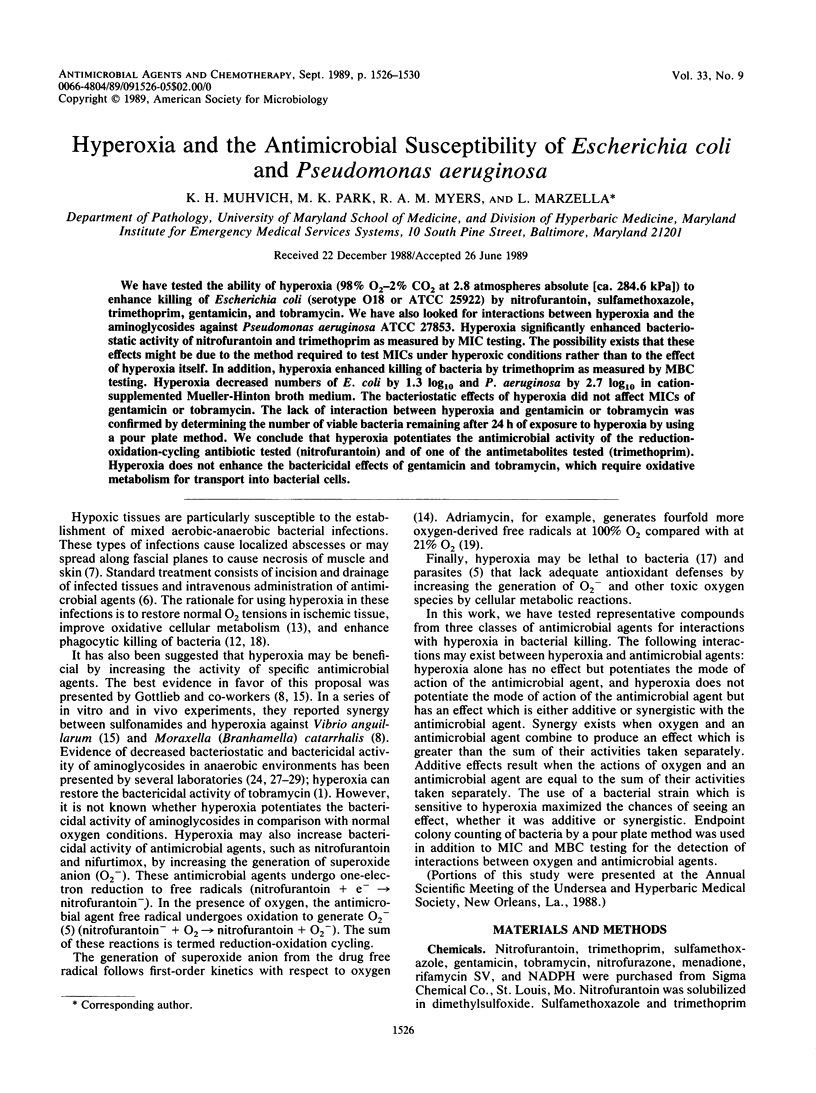
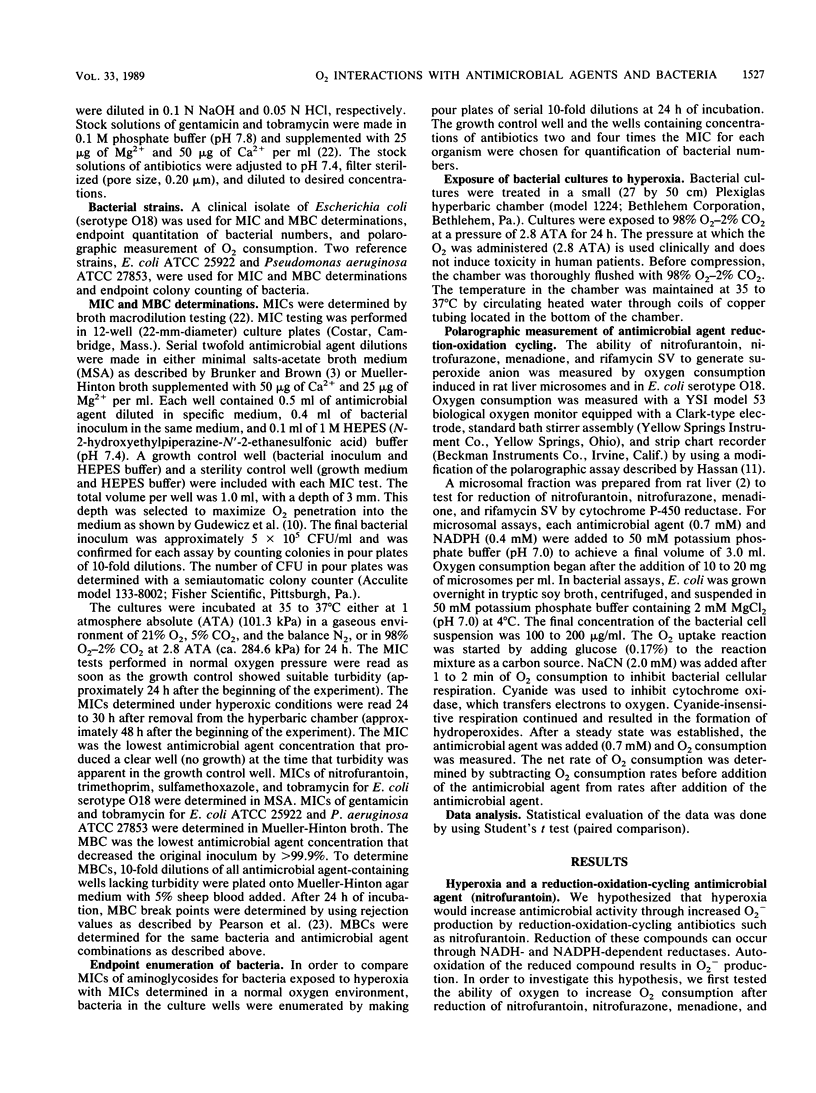
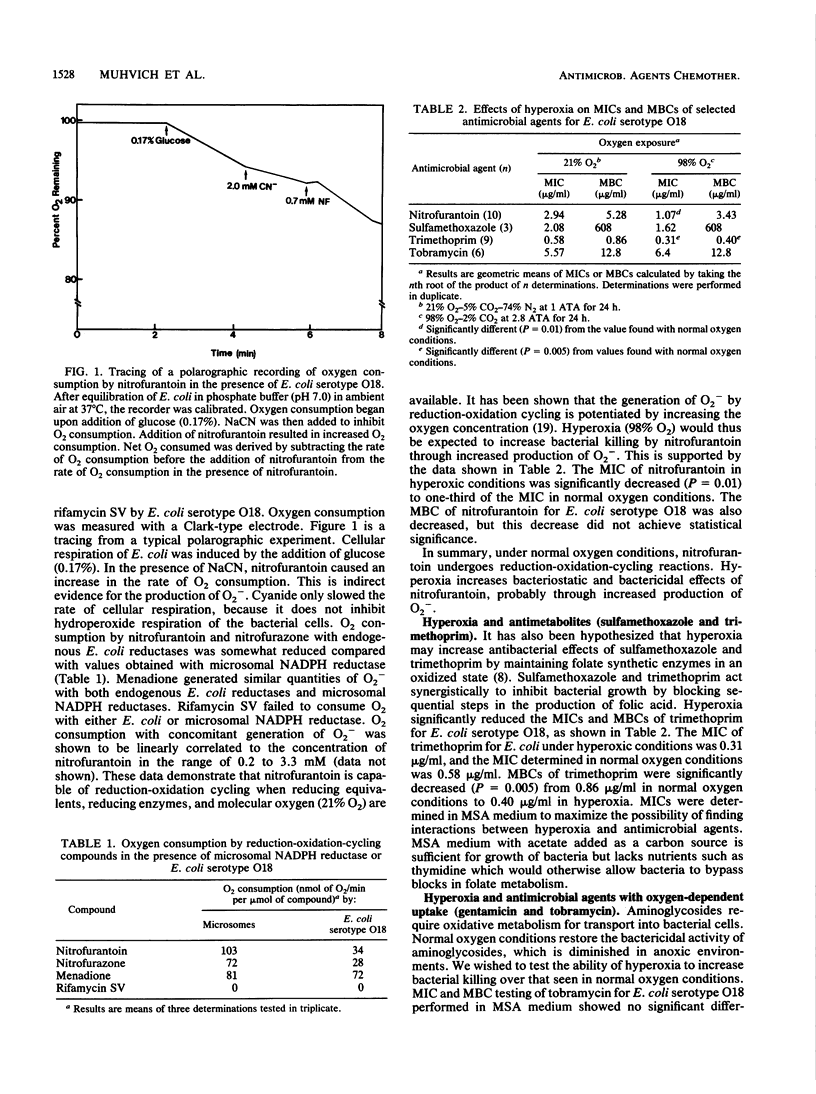
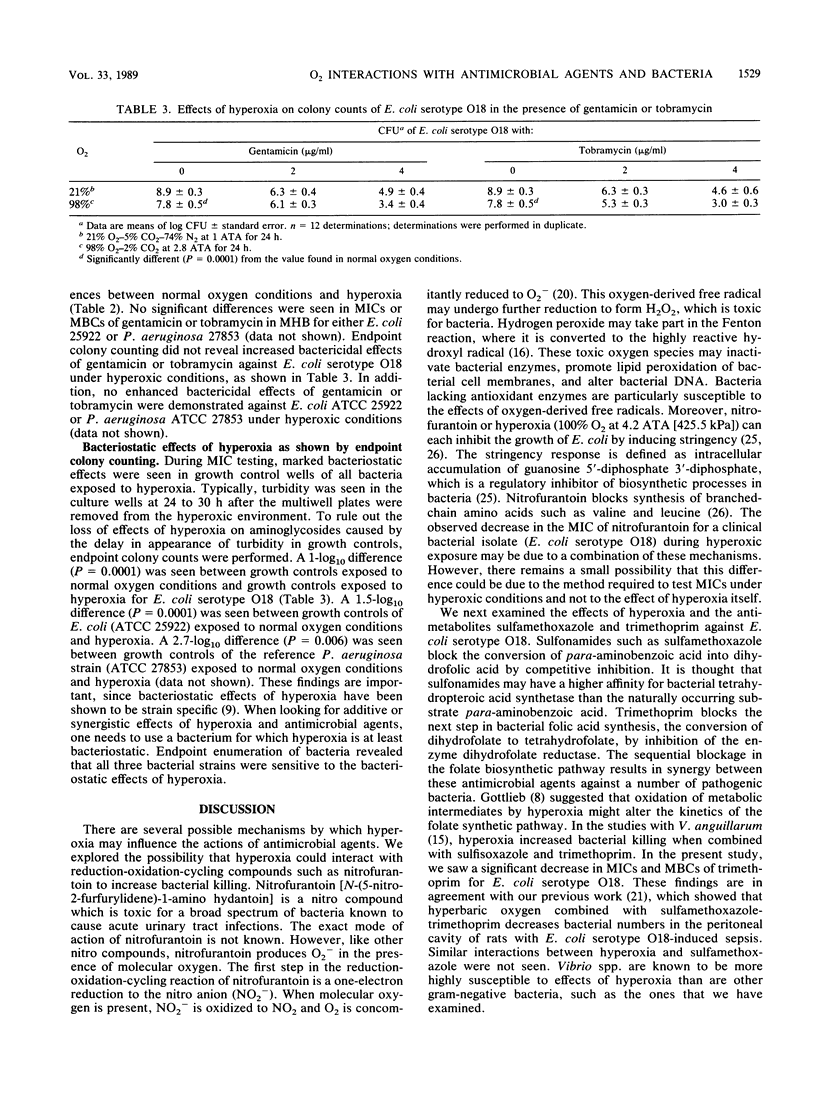
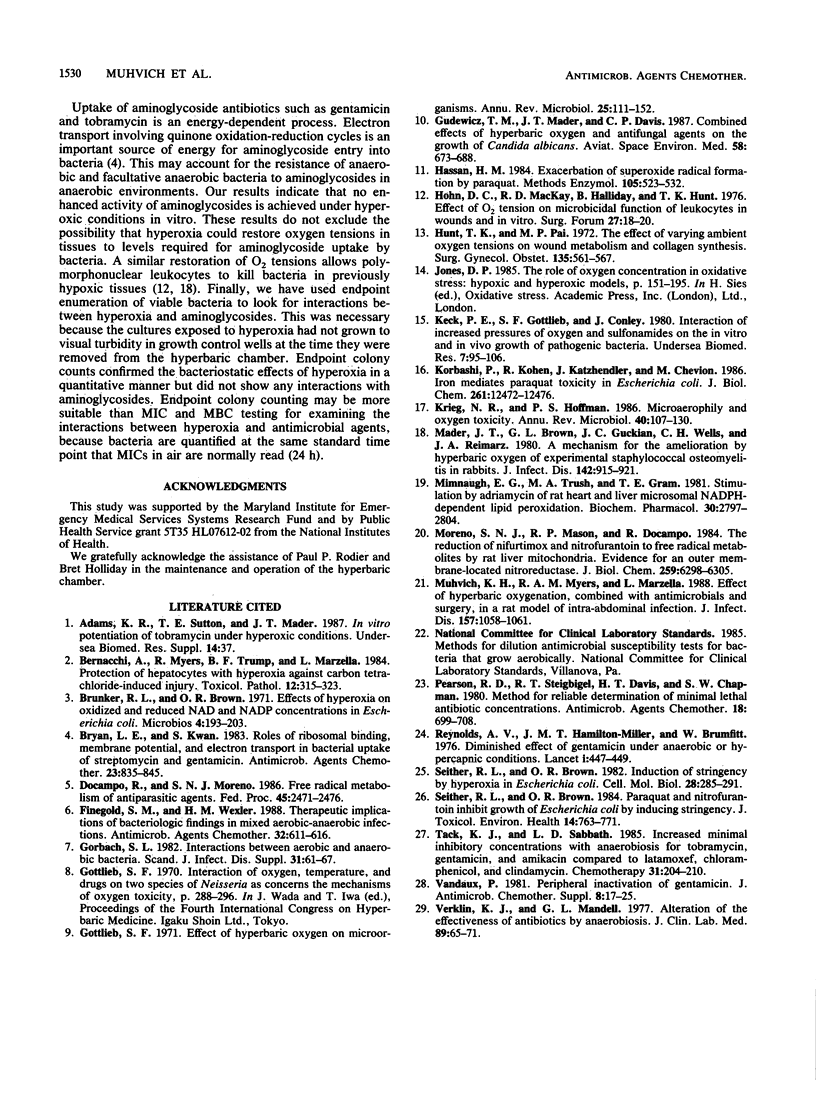
Selected References
These references are in PubMed. This may not be the complete list of references from this article.
- Bernacchi A., Myers R., Trump B. F., Marzella L. Protection of hepatocytes with hyperoxia against carbon tetrachloride-induced injury. Toxicol Pathol. 1984;12(4):315–323. doi: 10.1177/019262338401200403. [DOI] [PubMed] [Google Scholar]
- Brunker R. L., Brown O. R. Effects of hyperoxia on oxidized and reduced NAD and NADP concentrations in Escherichia coli. Microbios. 1971 Dec;4(15):193–203. [PubMed] [Google Scholar]
- Bryan L. E., Kwan S. Roles of ribosomal binding, membrane potential, and electron transport in bacterial uptake of streptomycin and gentamicin. Antimicrob Agents Chemother. 1983 Jun;23(6):835–845. doi: 10.1128/aac.23.6.835. [DOI] [PMC free article] [PubMed] [Google Scholar]
- Docampo R., Moreno S. N. Free radical metabolism of antiparasitic agents. Fed Proc. 1986 Sep;45(10):2471–2476. [PubMed] [Google Scholar]
- Finegold S. M., Wexler H. M. Therapeutic implications of bacteriologic findings in mixed aerobic-anaerobic infections. Antimicrob Agents Chemother. 1988 May;32(5):611–616. doi: 10.1128/aac.32.5.611. [DOI] [PMC free article] [PubMed] [Google Scholar]
- Gorbach S. L. Interactions between aerobic and anaerobic bacteria. Scand J Infect Dis Suppl. 1982;31:61–67. [PubMed] [Google Scholar]
- Gottlieb S. F. Effect of hyperbaric oxygen on microorganisms. Annu Rev Microbiol. 1971;25:111–152. doi: 10.1146/annurev.mi.25.100171.000551. [DOI] [PubMed] [Google Scholar]
- Gudewicz T. M., Mader J. T., Davis C. P. Combined effects of hyperbaric oxygen and antifungal agents on the growth of Candida albicans. Aviat Space Environ Med. 1987 Jul;58(7):673–678. [PubMed] [Google Scholar]
- Hassan H. M. Exacerbation of superoxide radical formation by paraquat. Methods Enzymol. 1984;105:523–532. doi: 10.1016/s0076-6879(84)05072-2. [DOI] [PubMed] [Google Scholar]
- Hohn D. C., MacKay R. D., Halliday B., Hunt T. K. Effect of O2 tension on microbicidal function of leukocytes in wounds and in vitro. Surg Forum. 1976;27(62):18–20. [PubMed] [Google Scholar]
- Hunt T. K., Pai M. P. The effect of varying ambient oxygen tensions on wound metabolism and collagen synthesis. Surg Gynecol Obstet. 1972 Oct;135(4):561–567. [PubMed] [Google Scholar]
- Keck P. E., Gottlieb S. F., Conley J. Interaction of increased pressures of oxygen and sulfonamides on the in vitro and in vivo growth of pathogenic bacteria. Undersea Biomed Res. 1980 Jun;7(2):95–106. [PubMed] [Google Scholar]
- Korbashi P., Kohen R., Katzhendler J., Chevion M. Iron mediates paraquat toxicity in Escherichia coli. J Biol Chem. 1986 Sep 25;261(27):12472–12476. [PubMed] [Google Scholar]
- Krieg N. R., Hoffman P. S. Microaerophily and oxygen toxicity. Annu Rev Microbiol. 1986;40:107–130. doi: 10.1146/annurev.mi.40.100186.000543. [DOI] [PubMed] [Google Scholar]
- Mader J. T., Brown G. L., Guckian J. C., Wells C. H., Reinarz J. A. A mechanism for the amelioration by hyperbaric oxygen of experimental staphylococcal osteomyelitis in rabbits. J Infect Dis. 1980 Dec;142(6):915–922. doi: 10.1093/infdis/142.6.915. [DOI] [PubMed] [Google Scholar]
- Mimnaugh E. G., Trush M. A., Gram T. E. Stimulation by adriamycin of rat heart and liver microsomal NADPH-dependent lipid peroxidation. Biochem Pharmacol. 1981 Oct;30(20):2797–2804. doi: 10.1016/0006-2952(81)90417-2. [DOI] [PubMed] [Google Scholar]
- Moreno S. N., Mason R. P., Docampo R. Reduction of nifurtimox and nitrofurantoin to free radical metabolites by rat liver mitochondria. Evidence of an outer membrane-located nitroreductase. J Biol Chem. 1984 May 25;259(10):6298–6305. [PubMed] [Google Scholar]
- Muhvich K. H., Myers R. A., Marzella L. Effect of hyperbaric oxygenation, combined with antimicrobial agents and surgery, in a rat model of intraabdominal infection. J Infect Dis. 1988 May;157(5):1058–1061. doi: 10.1093/infdis/157.5.1058. [DOI] [PubMed] [Google Scholar]
- Pearson R. D., Steigbigel R. T., Davis H. T., Chapman S. W. Method of reliable determination of minimal lethal antibiotic concentrations. Antimicrob Agents Chemother. 1980 Nov;18(5):699–708. doi: 10.1128/aac.18.5.699. [DOI] [PMC free article] [PubMed] [Google Scholar]
- Reynolds A. V., Hamilton-Miller J. M., Brumfitt W. Diminished effect of gentamicin under anaerobic or hypercapnic conditions. Lancet. 1976 Feb 28;1(7957):447–449. doi: 10.1016/s0140-6736(76)91474-4. [DOI] [PubMed] [Google Scholar]
- Seither R. L., Brown O. R. Induction of stringency by hyperoxia in Escherichia coli. Cell Mol Biol. 1982;28(3):285–291. [PubMed] [Google Scholar]
- Seither R. L., Brown O. R. Paraquat and nitrofurantoin inhibit growth of Escherichia coli by inducing stringency. J Toxicol Environ Health. 1984;14(5-6):763–771. doi: 10.1080/15287398409530625. [DOI] [PubMed] [Google Scholar]
- Tack K. J., Sabath L. D. Increased minimum inhibitory concentrations with anaerobiasis for tobramycin, gentamicin, and amikacin, compared to latamoxef, piperacillin, chloramphenicol, and clindamycin. Chemotherapy. 1985;31(3):204–210. doi: 10.1159/000238337. [DOI] [PubMed] [Google Scholar]
- Verklin R. M., Jr, Mandell G. L. Alteration of effectiveness of antibiotics by anaerobiosis. J Lab Clin Med. 1977 Jan;89(1):65–71. [PubMed] [Google Scholar]


